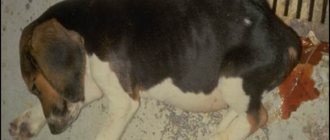How can hematemesis manifest in a dog?
Hematemesis is a word derived from Greek that means bloody vomiting. From the name it becomes clear that when the contents of the stomach or intestines flow back (reflux), blood is present in the vomit. Moreover, the appearance of these impurities can be very diverse - bright red, scarlet, pink, cherry, brown, black.
Therefore, a dog's vomit is red or another shade of that color. Both clots and individual bloody streaks, blood fibers, etc. may appear. All of the above indicates the presence of some form of bleeding in the gastrointestinal tract.
By the nature of the flow we can distinguish:
- an acute form that threatens the life of the pet,
- the average that she can pass on her own,
- quiet, which very often becomes chronic.
The most common cause of this phenomenon is ulcerative lesions of the gastrointestinal tract (ulceration) - the most severe factor! The ulcer, as a rule, has already opened and often its perforation affects large blood vessels.
Also the reason may be:
- foreign body
- severe helminthic infestation,
- generalized inflammatory process,
- oncology,
- severe poisoning (especially rat poison!),
- liver damage and dysfunction,
- injuries (for example, pneumothorax - the lung is pierced by a rib, etc.).
Important! In dogs, hematemesis very often occurs after consuming drugs such as diclofenac, ibuprofen, that is, drugs from the nonsteroidal anti-inflammatory drugs (NSAIDs) group!
Diagnostics
At the appointment, the veterinarian will conduct a thorough examination of your pet for mechanical damage, injuries, and other areas of possible bleeding. In addition, he will examine the animal's medical record to determine whether any previously diagnosed disease in the dog could have caused the vomiting.
To find out the reasons for the development of hematemesis, anamnesis is of great importance. The doctor will definitely ask the dog’s owner to tell him in as much detail as possible about his behavior and the characteristics of the vomiting process: the amount and consistency of the vomit, the frequency, duration and time of attacks.
- Vomiting immediately after eating most often occurs with diseases of the gastrointestinal tract.
- Diseases of the liver, pancreas or gall bladder may be accompanied by frequently recurring, debilitating bouts of vomiting.
- A characteristic sign of kidney failure or diabetes is the presence of an ammonia or acetone odor from the breath.
- The smell of rot can indicate advanced diseases of the stomach or intestines, and if the dog has not been able to pass a bowel movement for several days, it may have an intestinal obstruction.
- The combination of bloody vomiting, general weakness and fever gives reason to suspect an acute infectious disease: leptospirosis, parvovirus enteritis or the intestinal form of plague.
To diagnose the causes of hematemesis, blood tests (general, biochemical, coagulation), urine and stool tests are performed. If necessary, ultrasound and/or radiographic examination of the abdominal organs, as well as endoscopy of the esophagus, stomach and small intestine, are prescribed.
Types of hematemesis
Is your dog vomiting mucus and blood? In this case, it is very important to pay attention to the nature of the blood in the contents. If the blood is light in color and fresh in appearance (it has not been subjected to coagulation, it has not been affected by gastric juice), then most likely the pet has a foreign body in the throat. It could be, for example, a bone; it scratches the mucous membrane, and the dog tries to remove it through the gag reflex. In this case, mucus will be represented by saliva, which is released abundantly.
But when the blood is dark and clotted in appearance, the cause is hidden deeper. Hemorrhage occurs in the stomach and intestines.
If a dog vomits bile with blood, then this is a sign that, in addition to hemorrhage, there is damage to the liver, pancreas, gallbladder and its ducts, and small intestine. Bile becomes especially dark, dark green due to interaction with the blood. Such vomit will have dark shades and a very unpleasant, specific, sour odor. This picture is very typical for poisoning with rat poison. The liver and gastrointestinal tract are affected and the blood loses its ability to clot, which causes heavy bleeding.
Is your dog vomiting foam and blood? In most cases, there are two main options for the development of this disease.
The first option is a consequence of a chest injury, when a rib pierces the lung and blood, mixing with air in the form of foam, flies through the trachea into the pharynx and further out. It looks a lot like vomiting. The foam in such a situation is pink, or at most red, and the blood in it is fresh.
But when the blood in the foam has a dark tint and signs of coagulation, then the problem should be looked for in the gastrointestinal tract. This happens when a stomach ulcer breaks out, for example. This is a very serious condition; the sick individual almost does not eat. There is a lot of mucus in the stomach; during a spasm, the mucus mixes with the blood and, erupting, turns into foam, airy foam. This foam is very dark with a very unpleasant odor. This may be the case with the intestines, then there are still bile impurities.
Causes
Dog owners should pay attention to their pet if the following changes in the animal's behavior appear: restlessness, refusal to eat, excessive salivation and constant licking of the muzzle. All these symptoms are signs of nausea followed by vomiting.
Take the Attention Test! Find 10 differences! (click right here!)
Find the answer Are you bothered by some problem or question? Enter “Breed” or “Name of the problem” into the form, press Enter and you will find out everything about the issue that interests you.
Common reasons:
- Intoxication with poison, expired or spoiled food;
- Getting foreign objects into the throat, esophagus or stomach;
- Infectious, viral and chronic diseases;
- Intussusception;
- worms in dogs that live in the intestines;
- Overeating or hunger;
- Allergic reaction to products;
- Heat or sunstroke;
- Stress and diseases of the nervous system.
What does vomiting blood indicate?
This indicates the development of a dangerous pathology in the dog’s body - from a foreign object in the throat, poisoning with rat poison, to a burst stomach ulcer. In any case, this is a very bad symptom and the prognosis for the development of the disease that caused it is very cautious.
It is important to conduct an in-depth therapeutic study of your pet. There can be many reasons:
- poisoning,
- use of prohibited drugs (NSAIDs),
- severe helminthic infestation,
- various gastrointestinal infections,
- injuries,
- ulcer,
- severe inflammation of the mucous membranes,
- oncology,
- viral enteritis,
- hepatitis,
- fungal infection,
- postoperative complications.
All of the above may cause vomiting with blood and its inclusions, impurities, streaks, etc. In any case, this is a serious symptom that should not be neglected.
Causes of vomiting blood in dogs
Excessive vomiting in dogs is a protective mechanism of the body and is not dangerous in itself. But this phenomenon and its cause serve as a signal that the dog needs immediate veterinary help.
There are many reasons for an animal to vomit blood:
- Wrong diet.
- Poisoning. Most often, dogs eat rat poison, which causes bleeding.
- Diseases with blood clotting disorders. These include kidney and liver diseases, severe forms of enteropathy, oncology and mechanical injuries.
- Gastrointestinal ulcers.
- Swallowing objects. A similar chronic condition, where there is a bloody clot, appears when foreign objects enter the stomach, and the walls there are injured.
- Taking medications. The dog vomits when the pet takes non-steroidal drugs with anti-inflammatory effects, medications to reduce platelet levels in the blood.
- Chronic diseases.
- Presence of cancer.
Especially often, bloody vomiting occurs in dogs on the road. This is normal because the vestibular system is disrupted and the pet experiences stress.
Associated symptoms
Naturally, even with sluggish internal bleeding, the pet’s general condition worsens sharply. A disease with such a symptom can cause great harm to the dog’s body. Nausea appears, appetite sharply worsens, or even disappears completely. Very often, an already serious condition is complicated by diarrhea, which develops against the background of digestive problems. Bloody, mucous diarrhea is not uncommon.
When the liver is damaged, a problem arises with bilirubin in the body - the mucous membranes begin to turn yellow, and the urine becomes a rich yellow color. Infectious processes cause a sharp increase in the dog’s temperature. Large blood losses deplete the body, problems with hemoglobin begin, which leads to well-known problems.
If the bleeding is caused by helminthic infestation, then in this situation the parasites will come out in vomit and feces. Water-electrolyte balance and metabolism are greatly disturbed. The dog is losing weight and its eyes are sunken, the eyes “shiny” and have a cloudy appearance. The fur becomes dull and sometimes starts to shed a lot. The animal itself is looking for a dark, warm, hidden place, it is very restless.
First aid for vomiting blood
If you notice vomiting of blood in a puppy or an adult dog, you should immediately start a starvation diet and provide a calm environment for the animal. You should contact the clinic immediately, but if this is not possible, put ice or snow in the abdominal area. This will partially relieve vomiting and narrow the blood vessels in the abdominal cavity. Try to collect vomit so that the doctor can make a more accurate diagnosis after arriving to him.
Try to take actions aimed at relieving the pet’s state of shock.
In case of shock:
- rapid breathing,
- full pulse
- the temperature is increased,
- the reaction is inadequate.
After applying ice, you should warm the animal, but under no circumstances steam it.
Important! If you suspect a penetrating wound to the internal cavities, do not give anything to drink!
Abundant wetting of the lips and oral cavity with a sponge or clean cloth is allowed. This treatment (first aid) can be done independently at home. But it is imperative to show the animal to a veterinarian!
Treatment by a veterinarian
To understand why streaks of blood appear in dog vomit, the veterinarian will prescribe a series of tests for the animal. Among them:
- general examination of the animal;
- blood, urine, stool tests;
- Ultrasound, as well as x-rays of the abdominal cavity and chest;
- endoscopic examinations (necessary if an ulcer is suspected);
- other gastrointestinal studies.
Based on the results of the presented studies, the animal can be prescribed complex treatment. It provides:
- Taking antispasmodics (No-shpy), antiemetics (Cerucala).
- Using absorbents to remove toxins from the body. Polysorb, Smecta, and activated carbon can be prescribed as such.
- Taking immunomodulators.
If your dog is dehydrated, you may also be given drips of saline or glucose. The presence of an infectious disease requires antibiotics. For worms, the pet is given Prazicide or other anti-parasite remedies. For further recovery, the animal is given vitamin complexes and a special diet. On the first day after diagnosis, the animal can be kept in a veterinary clinic. If his condition improves, the pet will be discharged home and his owner will be given recommendations for further treatment. In a few days you will need to visit the veterinarian again to make sure everything is fine with the dog.
If there is serious damage to the animal's organs, surgery may be prescribed. It is necessary for perforation of the stomach and intestines. After this, the pet is prescribed to take antibiotics, treat the suture with an antiseptic, and general strengthening medications. The course of rehabilitation therapy can last several weeks.
If you contact a veterinarian in a timely manner and follow all his instructions, the prognosis for the puppy is favorable. Otherwise, the animal may die even during emergency surgery and other therapeutic measures. The most dangerous thing for your four-legged friend is poisoning, especially arsenic. Because of it, the dog can die in the very first day after ingesting such a substance. Death is possible even with emergency gastric lavage.
What medications can be used?
Medicines from a regular pharmacy will be useful for symptomatic treatment. But if the cause of vomiting blood is, for example, parasites in the intestines, then specific veterinary drugs such as albene and albendazole will be useful. True, pyrantel from a regular pharmacy will also help. In general, omeprazole (1 mg/kg once daily) and pantaprazole (11 mg/kg IV once every 24 hours) would be applicable. They will reduce the acidity of the stomach and its secretory function.
To dull the vomiting spasm, metoclopramide is useful at a dose of 1-2 mg/kg of animal weight once every 24 hours. The use of broad-spectrum antibiotics is indicated - penicillin, fluoroquinolone, cephalosporin.
There is also the practice of using pure medical alcohol. It is injected directly into the ulcer site using an endoscopic sclerotomy needle. Alcohol causes a sharp coagulation of the protein (cauterizes) and thereby heals the ulcer and stops bleeding.
Opioids are recommended for pain relief (in peak cases), but this is costly from a practical point of view in veterinary medicine. The drug no-spa is suitable for these purposes. The drug smecta is also recommended to relieve intoxication. In case of severe exhaustion, droppers from Ringer-Locke solution, Ringer solution, etc. are used.
Important! The antidote (means of counteracting, neutralizing) for poisoning with rat poison is vitamin K (for example, the drug Vikasol) for intramuscular injection in large doses! The higher the concentration, the more positive the therapeutic effect!
How to help a dog at home
If your pet has just vomited, he needs first aid.
The owner must take the following steps:
- Make sure your dog is not in shock. Its signs are pale gums, weakness, unsteady gait, depression. In this case, you should immediately visit a veterinarian.
- If the above symptoms are absent, place your pet in a warm room. If he is shaking, cover him with a blanket.
- Wipe the contaminated wool with a warm, damp cloth. Dried vomit cannot be washed off and hardens into shreds.
- Watch for signs of your next episode of vomiting.
- Make sure your dog has water in his bowl. Dehydration is dangerous for the body.
If the vomiting has stopped after 24 hours, the dog may be offered a small amount (eg a teaspoon) of easily digestible food. If there is no vomiting, you can start feeding in small portions 4-5 times a day. If the vomiting was caused by food poisoning, you can help the dog by offering it an enterosorbent.
| A drug | Dosage | Features of application |
| "Enterosgel" | for puppies - 1 teaspoon; adult dogs for every 5 kg of weight - 1/2 tsp. medicines, but not more than 2 spoons | The product is drawn into a syringe without a needle and instilled into the mouth. |
| "Polysorb" | 1/3 tsp for small dogs and up to 1 tsp. big | |
| "Kaopectate" | 1 tsp. for 20 kg weight | If there is a suspicion of infection with worms, then the drug should not be given. |
Instead of regular water, you can give water with chamomile infusion. For this, 1 tbsp. l. dry raw materials are poured with 1 cup of boiling water and left for 10 minutes. Then cool and pour 1 tsp into a dog bowl. for every 15 kg of animal weight. This decoction has antispasmodic properties. It soothes the digestive tract and helps reduce nausea.
Important! The dog sometimes burps to release excess air that it swallowed while trying to eat its food very quickly.
If your pet has been vomiting for more than 4 hours, has a bloody episode, bloating, or other symptoms that concern you, call your veterinarian and arrange an examination. It will be better if you find out that nothing bad is happening than to miss the symptoms of a dangerous infectious disease.
If the attacks are prolonged and repeat 2-3 times a day, then this condition is accompanied by other symptoms. In this case, anything can be done only after a visit to the veterinarian. He will examine the pet, conduct tests and give prescriptions.
Treatment for prolonged vomiting will include:
- Eliminating the cause that caused the dog to vomit blood.
- Restoring the body's alkaline balance using intravenous liquid therapy.
It is not recommended to give your dog medications unless prescribed. Vomiting helps the body rid itself of toxins. If you give an antiemetic, they will remain inside the body and the animal’s condition will become worse. In cases where an infectious infection is suspected, it is necessary to isolate the dog from other pets and family members. Be sure to wear latex gloves when feeding or caring for a sick dog.
Care after stopping vomiting
After a fasting diet, you should apply a gentle diet for 5-7 days. Give the animal food only in small portions and preferably at regular intervals, at the same time. Try not to disturb your pet again and eliminate any physical effort. Take him out for a walk for 10-15 minutes.
It is very important to use all the medications that are prescribed to treat your dog, and in no case should you interrupt the course prescribed by the veterinarian, or extend it yourself.
Closely monitor the patient’s general condition and inform the doctor if there is the slightest deterioration. Carry out thermometry at least 2-3 times a day. Avoid contact with other animals if possible. Don't expose your dog to stress!
Prevention
To avoid vomiting in your pet, follow these rules:
- Deworm your pet according to the schedule recommended by your doctor. Do not make exceptions even for those dogs that are rarely outdoors and have minimal risks of infection. Refusal to take anthelmintic drugs is one of the most common mistakes of animal owners, which leads to the development of various diseases in the latter.
- Give your pet exclusively fresh and high-quality food. Avoid sudden changes in feeding schedule and diet. Do not use untested canned dry food. Completely exclude rotten foods, salted, fried, smoked foods from the menu. Prohibit household members from giving your pet treats from the common table - many of them are not only not healthy, but even harmful for your four-legged friend.
- Limit the animal's access to medications, household chemicals, and poisons. Make sure that he does not pick up various objects on the street; be sure to practice the “No” command with him. After all, this is often how dogs swallow poisonous baits, rodent poison, and bread containing glass.
- Take your four-legged friend to the veterinarian regularly and undergo a full examination if necessary. This will allow timely identification of pathologies of internal organs that can provoke such a symptom, and treat them with conservative methods.
- If an animal has been diagnosed with a chronic disease that causes bloody vomiting, it is important to give it special medications to avoid exacerbation of the disease. The schedule for their administration and dosage are determined by the veterinarian based on the diagnostic results.
Also, be sure to monitor your dog’s condition. Seek medical help immediately if you notice that your dog is not eating anything, refusing his favorite treats, not playing, or sleeping for a long time. Remember: the sooner you start treating existing pathologies, the less harm they will cause to the animal’s body.
Prevention of hematemesis in animals
Clinically healthy animals with strong immunity are less susceptible to the development of hematemesis (bloody vomiting) and the causes that cause it. The key to this is a healthy, nutritious diet, proper care, maintenance and proper physical activity depending on the breed of your dog.
Meals should be regular and preferably on a schedule at the same time. Don't skip vaccinations, especially if you have a puppy. Deworm regularly. Prohibit dogs from picking up anything on the street to avoid poisoning. Do not feed bones with sharp edges, large bone fragments, etc.
If dogs have health problems, then try not to let the illnesses become chronic, as this will make the dog very weak and be predisposed to hematemesis. Regularly use vitamins, nutritional supplements, vitamin complexes during the period of possible vitamin deficiency. Use high-quality raw materials for nutrition and only good, licensed feed. Make sure that the puppy does not swallow a foreign body!
Varieties
When you discover that your pet is vomiting blood, you need to pay special attention to the type and composition of the vomit and the accompanying symptoms. This will subsequently help the veterinarian determine the diagnosis, and will tell you what exactly was the main reason for such a change in well-being.
Depending on the amount and color, vomiting can be:
- Blood that is bright scarlet in color indicates injury to the mouth or trachea. Carefully inspect the mouth for wounds or scratches, paying special attention to the tongue and sublingual space. If you notice a thread loop leading from the gastrointestinal tract, it means the animal has an obstruction.
- Black and dark brown colors indicate kidney problems or severe poisoning of the body. Kidney failure, enteritis, and the influence of strong poison also cause diarrhea, and subsequently anemia, a symptom of which is pallor of the mucous membranes. Another sign - a hint - is the appearance of an ammonia odor from the mouth.
- Brown spots are an indicator of bleeding in the stomach area. This could be an ulcer or other injury of the same type. An extremely dangerous symptom that requires prompt hospitalization.
conclusions
Vomiting blood (hematemesis) is a serious symptom and requires immediate treatment and diagnosis of the cause. The reasons are very diverse; the stress factor in this situation can be anything - from a burst ulcer, injury, foreign body to poisoning! Rat poisoning is especially dangerous! Antidote – vitamin K (Vikasol intramuscularly). Medicines can be purchased at a regular pharmacy without a prescription. Healthy, strong dogs are less susceptible to developing hematemesis!
Please follow and like us:
Nikitin Sergey
I write about dogs based on the experience and knowledge gained during my studies as a veterinarian, work in my specialty, and simply from observing my pets.
Pet care
In order for the animal to recover easily and quickly after treatment, it needs to be provided with good living conditions. They provide:
- Following a strict diet. In the first days, the dog should be limited in food; immediately after taking medications, it is better not to feed him, so as not to provoke a relapse of vomiting. In the future, it is necessary to give him exclusively light food, and, if possible, stick to specialized medicinal food.
- Complete peace. In the first days, it is necessary to limit the dog's walking (especially if it has been diagnosed with infectious diseases or helminthiasis), you can reduce training or completely abandon it. After abdominal surgery, you will have to refuse to participate in exhibitions and other similar events.
- Protect your pet from contact with other animals.
- Make sure that the dog is comfortable in the house. It is recommended to give him new bedding and make sure that he does not lie on a draft or cold floor. If the animal lives in a kennel, it is better to move it into a house during treatment.
Also, after the operation, it is necessary to regularly treat the pet’s suture and make dressings. If you cannot do this yourself, contact your veterinarian regarding this issue. Also keep your doctor informed about your four-legged friend's condition. Don't be afraid to disturb him if any alarming symptoms appear. This is the only way you can help the beast.
Video: what to do if your dog is vomiting blood? Causes and treatment of this problem











